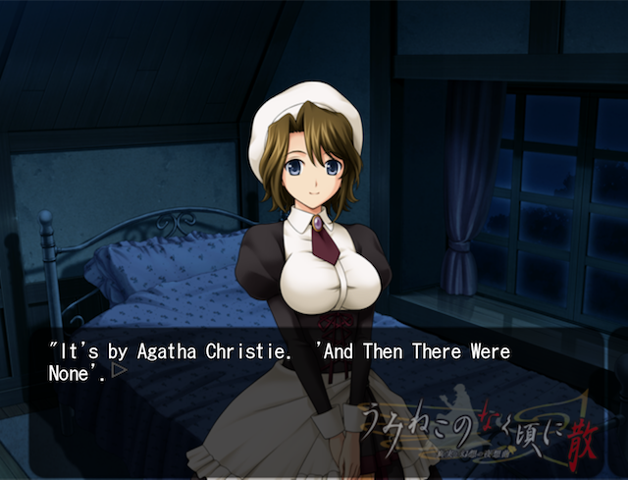
And Then There Were None by Agatha Christie is the best-selling novel of the best-selling novelist of all time. (For those of you who whine about female writers facing discrimination, please choke on Agatha Christie’s enormous strap-on.) More importantly, ATTWN is the classic mystery novel that inspired Umineko no Naku Koro ni.
ATTWN is the mystery of 10 people who are killed one by one on a secluded island in accordance with a politically incorrect poem. Umineko attempted to improve upon this concept by adding witches and incest. Unfortunately, it also added the following:
- themes of love/joy/forgiveness
- verbiage
- tangential rambling
- repitition
- redudancy
- saying the same thing over and over again
- metafiction
ATTWN was short and to the point. Umineko was needlessly long. ATTWN gave you a direct solution. Umineko refused to tell all, instead making you go back and read it over again if you want to piece the clues together. ATTWN kept its murders fresh. Umineko had more murders, but most of them are slight variations of the same closed-door puzzle. The only advantages to Umineko are the complexity, character development, character design, and background music.
If you’re too lazy to read ATTWN, you could listen to the audiobook version (I am, and I did). If you’re still too lazy for that, the copyright was allowed to lapse for the 1945 movie version, so you can legally view it online for free, just like you surely do with anime. Be forewarned however, the director had the bull testicles to turn ATTWN into a comedy and give it a happy ending. It also has a random cat.
The thing I particularly enjoyed about ATTWN was the muddying of the waters involved in the very premise.
If everyone is the killer, then how are you supposed to make the call on who’s the killer *this* time? If you’re anything like the average reader, the answer’s probably gonna be, “get suckered into making a value judgment on which of the group seems the coolest or most like a ‘decent’ sort, and forget that they’re all actually terrible people.”
At any rate, it was a very lively story that was composed almost entirely of implication and inference, meshing well with the mystery novel format that already encourages the reader to become invested in the “what ifs” and “how dids”. When the climax hits and the false plot direction thus far (that you’ve been suckered into believing) suddenly falls away, revealing a hungry maw that swallows the remaining cast – but only after exposing their vices and flaws in the ugliest light – I’d wager vanishingly few people would even realize what’s going on, let alone have the energy to guess at hidden plot threads.
The epilogue that follows is probably one of the most necessary denouements in the genre.
The “everyone’s a killer” setup shouldn’t have to be limited to murder mysteries. I’d be ok with this in a harem or slice-of-life story as well. In any case, it beats the hell out of the Umineko premise of, “Everyone here LOVES each other! You need to understand LOVE to understand the murders!”
My one regret is that I watched/read Umineko before ATTWN. While I wasn’t able to pinpoint the murderer in ATTWN, I never felt lost or confused due to all the “training” Umineko put me through. It was still a badass story, but the biggest “what if” for me was, “What if I’d never read Umineko? How much cooler would this book have been?”
Tbh I’m not a big fan of the crime/mystery genre, but I think I should give Agatha Christie a try. Maybe I’ll even start with ATTWN, it sounds kind of interesting.
You should try reading “Murder on the Orient Express” while you’re at it. I’d say Umineko’s later parts actually draws more inspiration from it than from ATTWN, because of how the ending toys with the whole idea of double truth, and “what ever people believe/want to believe becomes the the real truth if there are no evidence”. Besides it’s a great novel all around.
I listened to Murder on the Orient Express after ATTWN. At first I found the second solution cheap and frustrating (though I loved the dual ending). Then upon watching the movie and thinking about it some more, damn, it’s really slick how it gets solved.
I’m on The Murder of Roger Ackroyd right now. From digging around, these three novels seem to be her best.
UPDATE: Umineko is a combination of:
– The premise of And Then There Were None
– The dual ending of Murder on the Orient Express
– The unreliable narrator of The Murder of Rogery Ackroyd
DO IT
So we may assume you finished reading episode 8? If so, what’s your take on the solution?
Yes I have. Post forthcoming.
(Right now I’m rewatching the anime and reading some other interpretations of Umineko. The post will come when I’m done with all that.)
And a badass pimp in a white suit. In Chiru, a badass pimp in a white suit with a cape on top.
Random Cat was Bern?
Bern or Sakutaro, whichever solution you prefer.
The cape should’ve been the main character. It stole the show.